Principles of Marketing Assignment
VerifiedAdded on 2020/06/03
|13
|3974
|278
AI Summary
This assignment delves into the fundamental principles of marketing. It examines various concepts such as service logic, partial least squares structural equation modeling, and social marketing campaigns. Students are expected to analyze marketing challenges, understand different perspectives on marketing definition, and apply marketing principles to real-world scenarios.
Contribute Materials
Your contribution can guide someone’s learning journey. Share your
documents today.
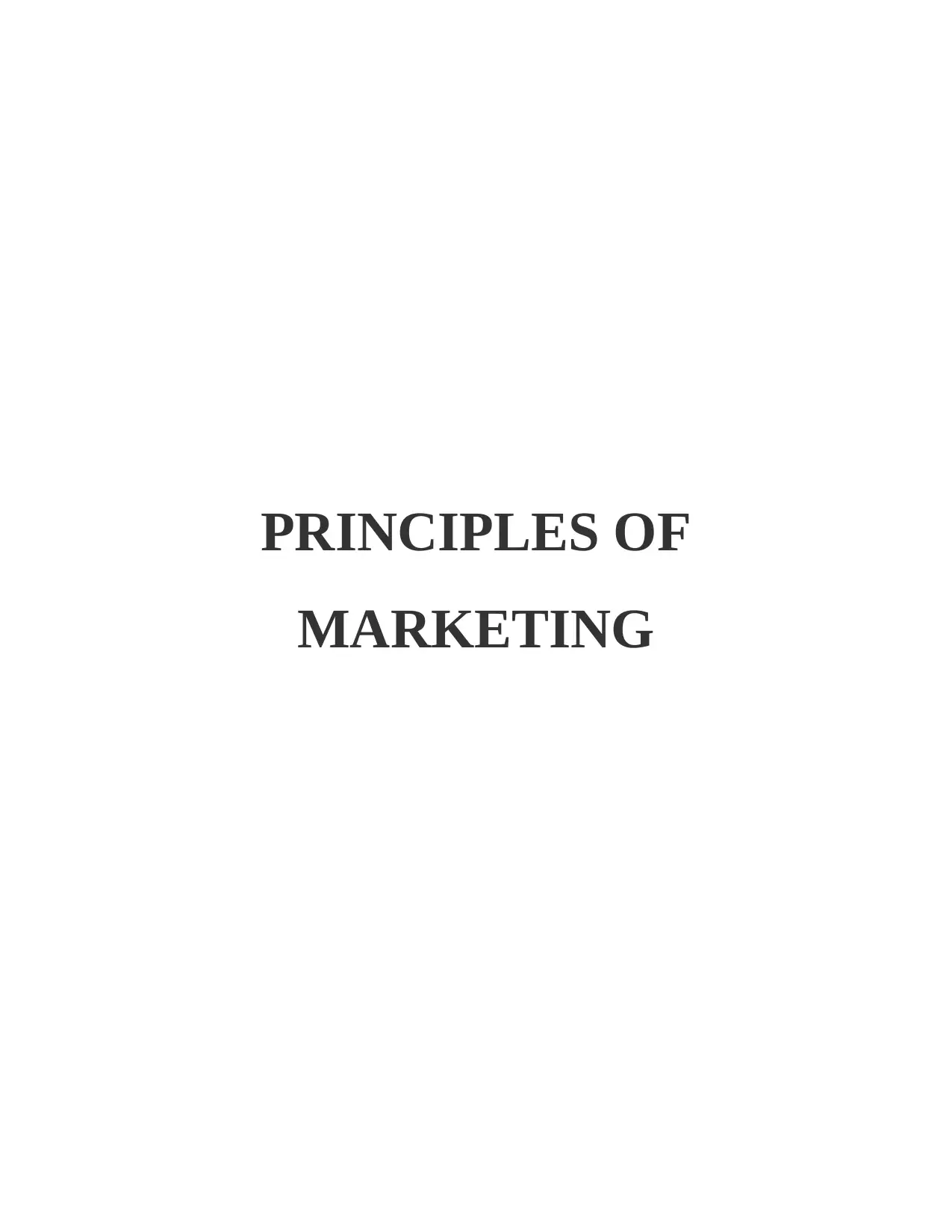
PRINCIPLES OF
MARKETING
MARKETING
Secure Best Marks with AI Grader
Need help grading? Try our AI Grader for instant feedback on your assignments.
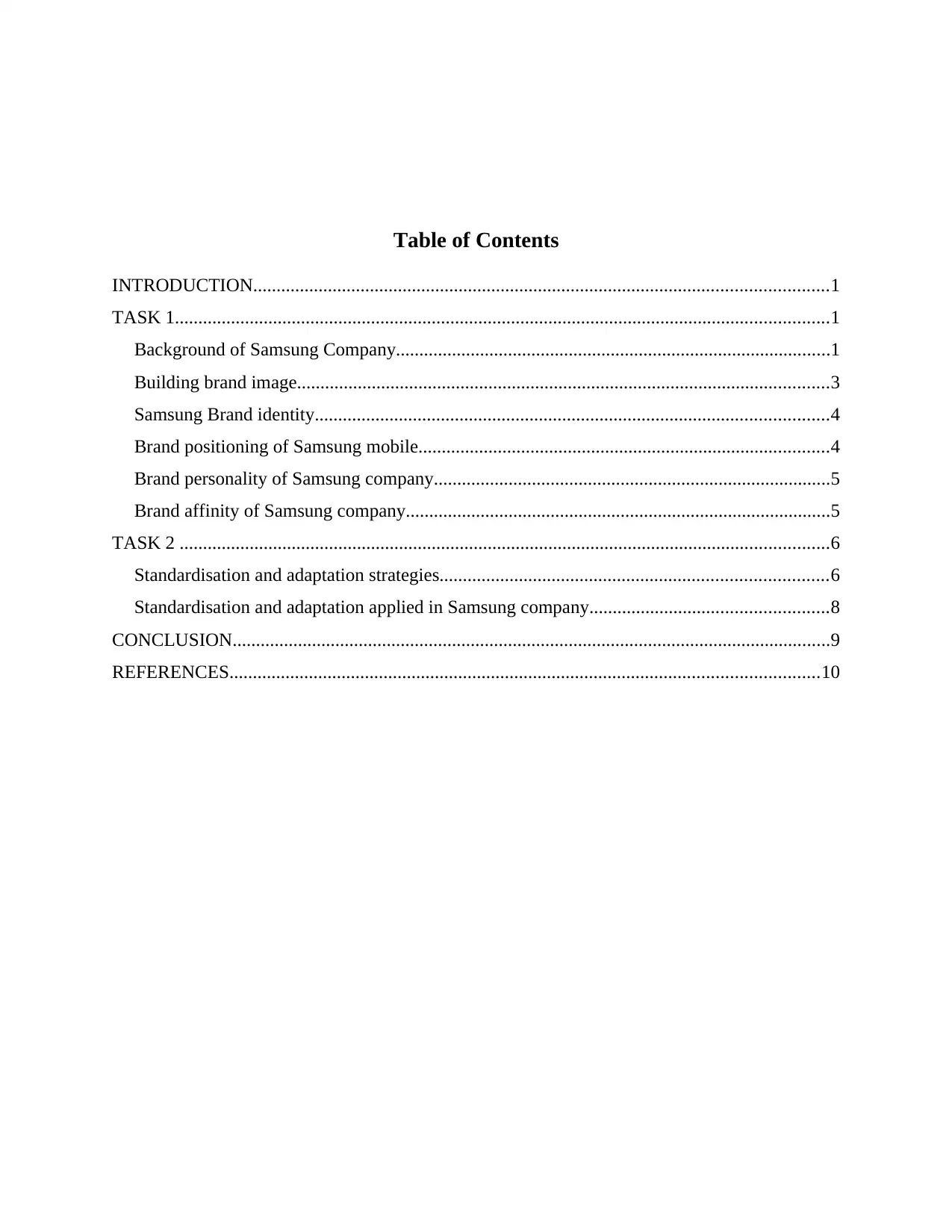
Table of Contents
INTRODUCTION...........................................................................................................................1
TASK 1............................................................................................................................................1
Background of Samsung Company.............................................................................................1
Building brand image..................................................................................................................3
Samsung Brand identity..............................................................................................................4
Brand positioning of Samsung mobile........................................................................................4
Brand personality of Samsung company.....................................................................................5
Brand affinity of Samsung company...........................................................................................5
TASK 2 ...........................................................................................................................................6
Standardisation and adaptation strategies...................................................................................6
Standardisation and adaptation applied in Samsung company...................................................8
CONCLUSION................................................................................................................................9
REFERENCES..............................................................................................................................10
INTRODUCTION...........................................................................................................................1
TASK 1............................................................................................................................................1
Background of Samsung Company.............................................................................................1
Building brand image..................................................................................................................3
Samsung Brand identity..............................................................................................................4
Brand positioning of Samsung mobile........................................................................................4
Brand personality of Samsung company.....................................................................................5
Brand affinity of Samsung company...........................................................................................5
TASK 2 ...........................................................................................................................................6
Standardisation and adaptation strategies...................................................................................6
Standardisation and adaptation applied in Samsung company...................................................8
CONCLUSION................................................................................................................................9
REFERENCES..............................................................................................................................10

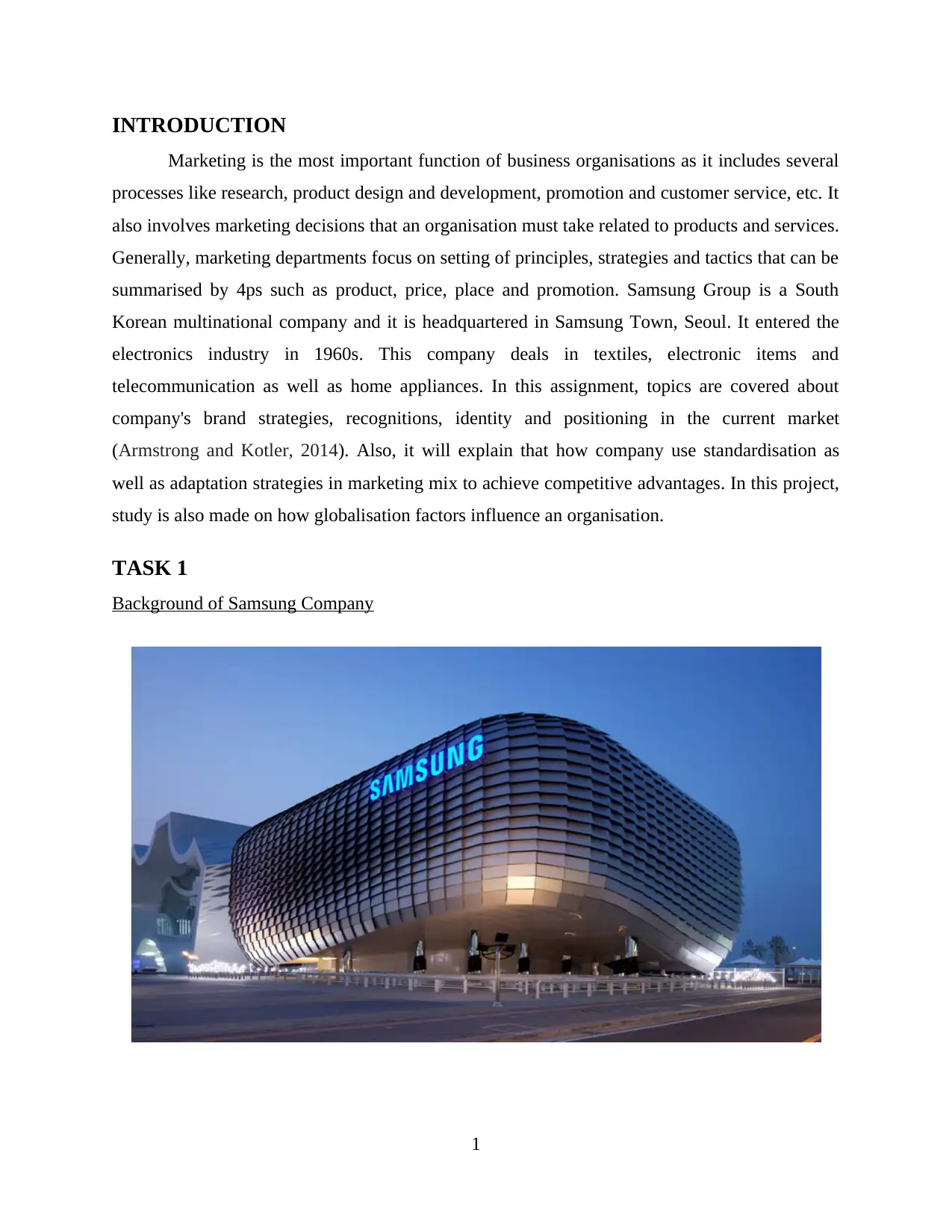
INTRODUCTION
Marketing is the most important function of business organisations as it includes several
processes like research, product design and development, promotion and customer service, etc. It
also involves marketing decisions that an organisation must take related to products and services.
Generally, marketing departments focus on setting of principles, strategies and tactics that can be
summarised by 4ps such as product, price, place and promotion. Samsung Group is a South
Korean multinational company and it is headquartered in Samsung Town, Seoul. It entered the
electronics industry in 1960s. This company deals in textiles, electronic items and
telecommunication as well as home appliances. In this assignment, topics are covered about
company's brand strategies, recognitions, identity and positioning in the current market
(Armstrong and Kotler, 2014). Also, it will explain that how company use standardisation as
well as adaptation strategies in marketing mix to achieve competitive advantages. In this project,
study is also made on how globalisation factors influence an organisation.
TASK 1
Background of Samsung Company
1
Marketing is the most important function of business organisations as it includes several
processes like research, product design and development, promotion and customer service, etc. It
also involves marketing decisions that an organisation must take related to products and services.
Generally, marketing departments focus on setting of principles, strategies and tactics that can be
summarised by 4ps such as product, price, place and promotion. Samsung Group is a South
Korean multinational company and it is headquartered in Samsung Town, Seoul. It entered the
electronics industry in 1960s. This company deals in textiles, electronic items and
telecommunication as well as home appliances. In this assignment, topics are covered about
company's brand strategies, recognitions, identity and positioning in the current market
(Armstrong and Kotler, 2014). Also, it will explain that how company use standardisation as
well as adaptation strategies in marketing mix to achieve competitive advantages. In this project,
study is also made on how globalisation factors influence an organisation.
TASK 1
Background of Samsung Company
1
Secure Best Marks with AI Grader
Need help grading? Try our AI Grader for instant feedback on your assignments.
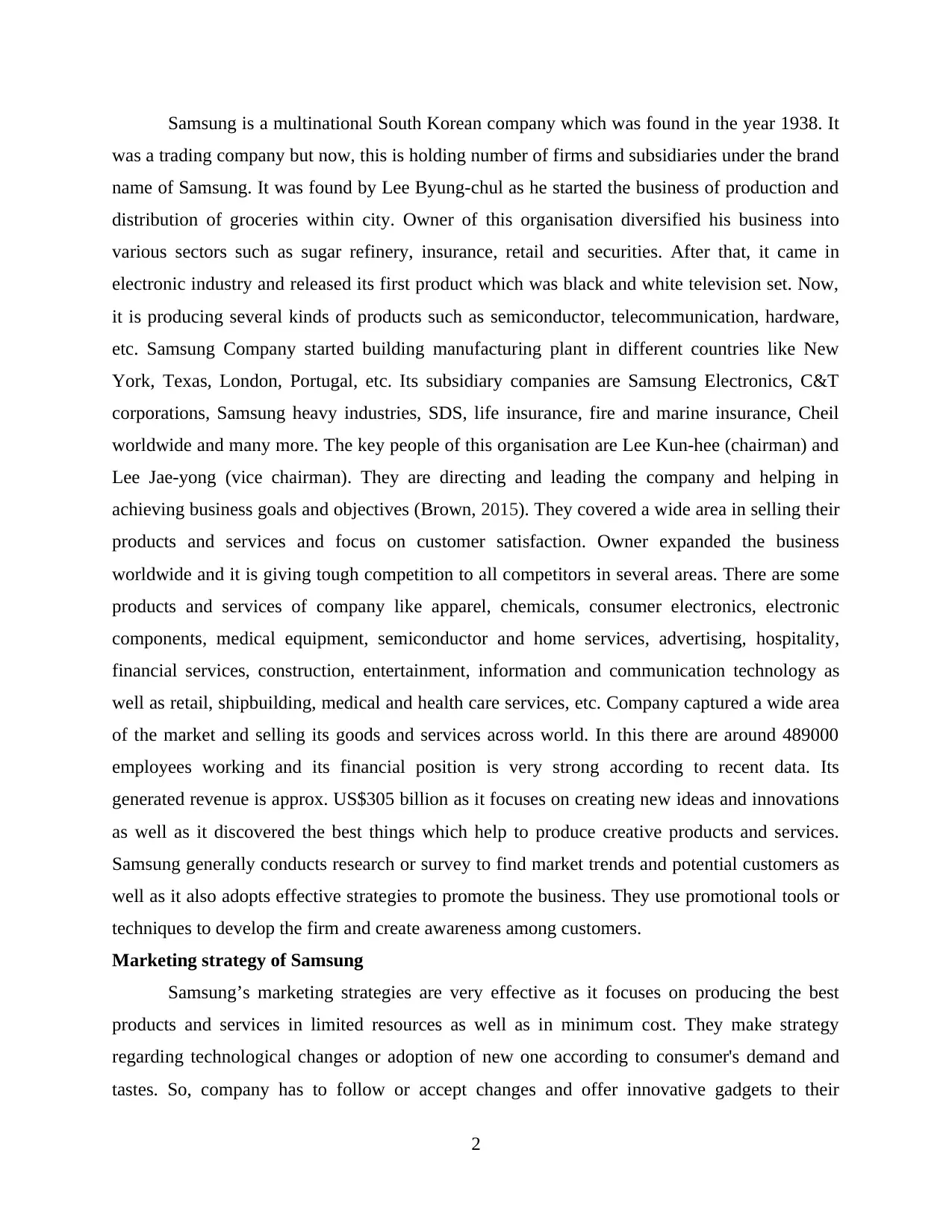
Samsung is a multinational South Korean company which was found in the year 1938. It
was a trading company but now, this is holding number of firms and subsidiaries under the brand
name of Samsung. It was found by Lee Byung-chul as he started the business of production and
distribution of groceries within city. Owner of this organisation diversified his business into
various sectors such as sugar refinery, insurance, retail and securities. After that, it came in
electronic industry and released its first product which was black and white television set. Now,
it is producing several kinds of products such as semiconductor, telecommunication, hardware,
etc. Samsung Company started building manufacturing plant in different countries like New
York, Texas, London, Portugal, etc. Its subsidiary companies are Samsung Electronics, C&T
corporations, Samsung heavy industries, SDS, life insurance, fire and marine insurance, Cheil
worldwide and many more. The key people of this organisation are Lee Kun-hee (chairman) and
Lee Jae-yong (vice chairman). They are directing and leading the company and helping in
achieving business goals and objectives (Brown, 2015). They covered a wide area in selling their
products and services and focus on customer satisfaction. Owner expanded the business
worldwide and it is giving tough competition to all competitors in several areas. There are some
products and services of company like apparel, chemicals, consumer electronics, electronic
components, medical equipment, semiconductor and home services, advertising, hospitality,
financial services, construction, entertainment, information and communication technology as
well as retail, shipbuilding, medical and health care services, etc. Company captured a wide area
of the market and selling its goods and services across world. In this there are around 489000
employees working and its financial position is very strong according to recent data. Its
generated revenue is approx. US$305 billion as it focuses on creating new ideas and innovations
as well as it discovered the best things which help to produce creative products and services.
Samsung generally conducts research or survey to find market trends and potential customers as
well as it also adopts effective strategies to promote the business. They use promotional tools or
techniques to develop the firm and create awareness among customers.
Marketing strategy of Samsung
Samsung’s marketing strategies are very effective as it focuses on producing the best
products and services in limited resources as well as in minimum cost. They make strategy
regarding technological changes or adoption of new one according to consumer's demand and
tastes. So, company has to follow or accept changes and offer innovative gadgets to their
2
was a trading company but now, this is holding number of firms and subsidiaries under the brand
name of Samsung. It was found by Lee Byung-chul as he started the business of production and
distribution of groceries within city. Owner of this organisation diversified his business into
various sectors such as sugar refinery, insurance, retail and securities. After that, it came in
electronic industry and released its first product which was black and white television set. Now,
it is producing several kinds of products such as semiconductor, telecommunication, hardware,
etc. Samsung Company started building manufacturing plant in different countries like New
York, Texas, London, Portugal, etc. Its subsidiary companies are Samsung Electronics, C&T
corporations, Samsung heavy industries, SDS, life insurance, fire and marine insurance, Cheil
worldwide and many more. The key people of this organisation are Lee Kun-hee (chairman) and
Lee Jae-yong (vice chairman). They are directing and leading the company and helping in
achieving business goals and objectives (Brown, 2015). They covered a wide area in selling their
products and services and focus on customer satisfaction. Owner expanded the business
worldwide and it is giving tough competition to all competitors in several areas. There are some
products and services of company like apparel, chemicals, consumer electronics, electronic
components, medical equipment, semiconductor and home services, advertising, hospitality,
financial services, construction, entertainment, information and communication technology as
well as retail, shipbuilding, medical and health care services, etc. Company captured a wide area
of the market and selling its goods and services across world. In this there are around 489000
employees working and its financial position is very strong according to recent data. Its
generated revenue is approx. US$305 billion as it focuses on creating new ideas and innovations
as well as it discovered the best things which help to produce creative products and services.
Samsung generally conducts research or survey to find market trends and potential customers as
well as it also adopts effective strategies to promote the business. They use promotional tools or
techniques to develop the firm and create awareness among customers.
Marketing strategy of Samsung
Samsung’s marketing strategies are very effective as it focuses on producing the best
products and services in limited resources as well as in minimum cost. They make strategy
regarding technological changes or adoption of new one according to consumer's demand and
tastes. So, company has to follow or accept changes and offer innovative gadgets to their
2
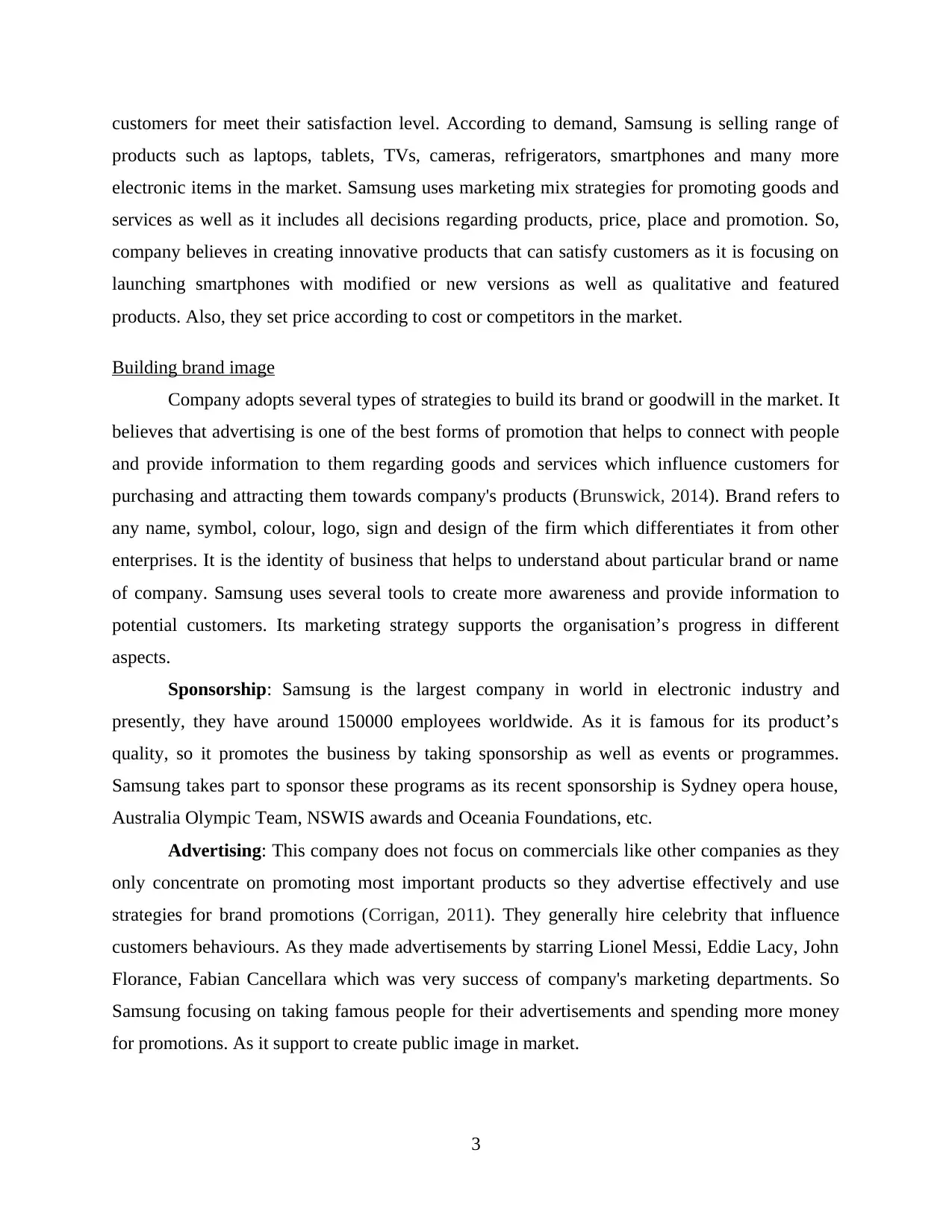
customers for meet their satisfaction level. According to demand, Samsung is selling range of
products such as laptops, tablets, TVs, cameras, refrigerators, smartphones and many more
electronic items in the market. Samsung uses marketing mix strategies for promoting goods and
services as well as it includes all decisions regarding products, price, place and promotion. So,
company believes in creating innovative products that can satisfy customers as it is focusing on
launching smartphones with modified or new versions as well as qualitative and featured
products. Also, they set price according to cost or competitors in the market.
Building brand image
Company adopts several types of strategies to build its brand or goodwill in the market. It
believes that advertising is one of the best forms of promotion that helps to connect with people
and provide information to them regarding goods and services which influence customers for
purchasing and attracting them towards company's products (Brunswick, 2014). Brand refers to
any name, symbol, colour, logo, sign and design of the firm which differentiates it from other
enterprises. It is the identity of business that helps to understand about particular brand or name
of company. Samsung uses several tools to create more awareness and provide information to
potential customers. Its marketing strategy supports the organisation’s progress in different
aspects.
Sponsorship: Samsung is the largest company in world in electronic industry and
presently, they have around 150000 employees worldwide. As it is famous for its product’s
quality, so it promotes the business by taking sponsorship as well as events or programmes.
Samsung takes part to sponsor these programs as its recent sponsorship is Sydney opera house,
Australia Olympic Team, NSWIS awards and Oceania Foundations, etc.
Advertising: This company does not focus on commercials like other companies as they
only concentrate on promoting most important products so they advertise effectively and use
strategies for brand promotions (Corrigan, 2011). They generally hire celebrity that influence
customers behaviours. As they made advertisements by starring Lionel Messi, Eddie Lacy, John
Florance, Fabian Cancellara which was very success of company's marketing departments. So
Samsung focusing on taking famous people for their advertisements and spending more money
for promotions. As it support to create public image in market.
3
products such as laptops, tablets, TVs, cameras, refrigerators, smartphones and many more
electronic items in the market. Samsung uses marketing mix strategies for promoting goods and
services as well as it includes all decisions regarding products, price, place and promotion. So,
company believes in creating innovative products that can satisfy customers as it is focusing on
launching smartphones with modified or new versions as well as qualitative and featured
products. Also, they set price according to cost or competitors in the market.
Building brand image
Company adopts several types of strategies to build its brand or goodwill in the market. It
believes that advertising is one of the best forms of promotion that helps to connect with people
and provide information to them regarding goods and services which influence customers for
purchasing and attracting them towards company's products (Brunswick, 2014). Brand refers to
any name, symbol, colour, logo, sign and design of the firm which differentiates it from other
enterprises. It is the identity of business that helps to understand about particular brand or name
of company. Samsung uses several tools to create more awareness and provide information to
potential customers. Its marketing strategy supports the organisation’s progress in different
aspects.
Sponsorship: Samsung is the largest company in world in electronic industry and
presently, they have around 150000 employees worldwide. As it is famous for its product’s
quality, so it promotes the business by taking sponsorship as well as events or programmes.
Samsung takes part to sponsor these programs as its recent sponsorship is Sydney opera house,
Australia Olympic Team, NSWIS awards and Oceania Foundations, etc.
Advertising: This company does not focus on commercials like other companies as they
only concentrate on promoting most important products so they advertise effectively and use
strategies for brand promotions (Corrigan, 2011). They generally hire celebrity that influence
customers behaviours. As they made advertisements by starring Lionel Messi, Eddie Lacy, John
Florance, Fabian Cancellara which was very success of company's marketing departments. So
Samsung focusing on taking famous people for their advertisements and spending more money
for promotions. As it support to create public image in market.
3
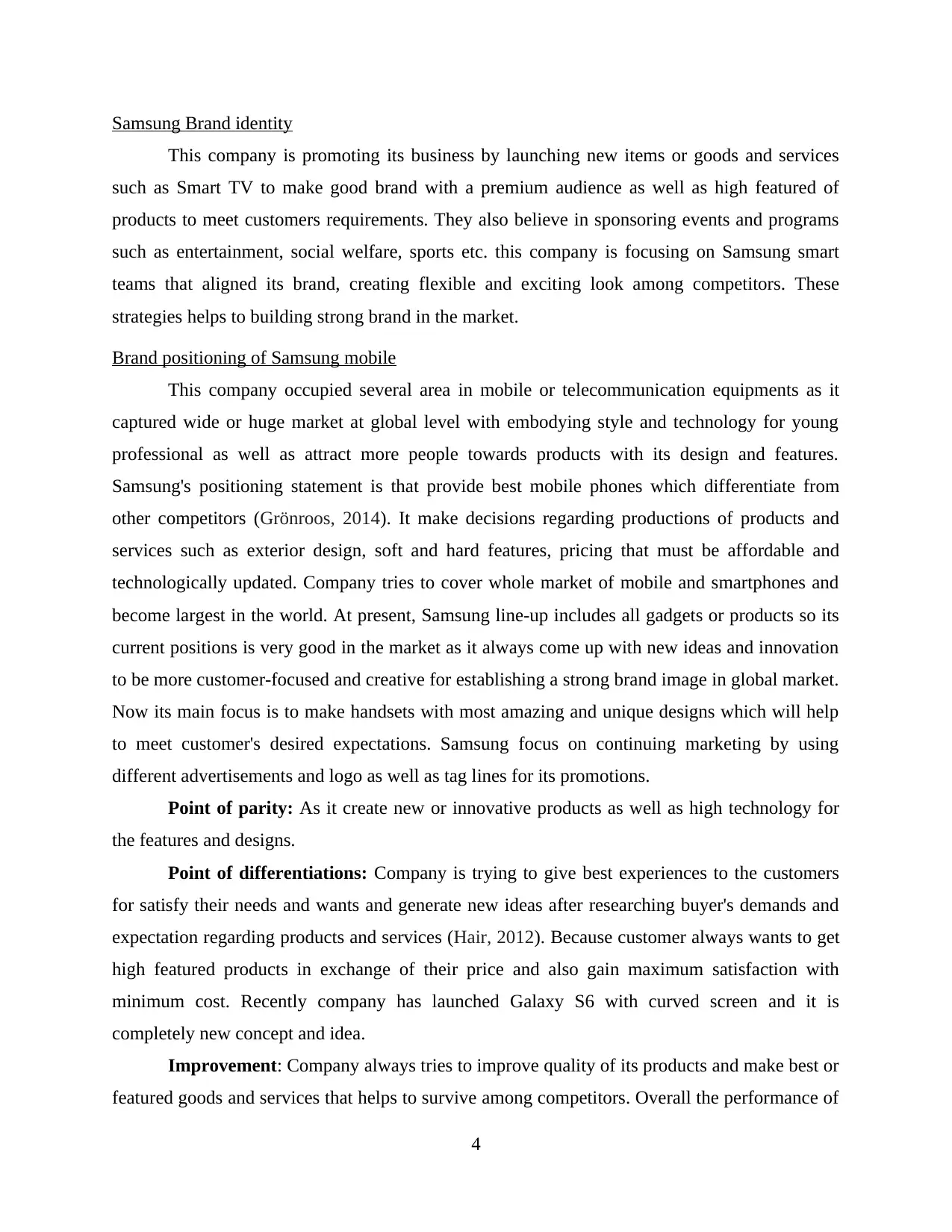
Samsung Brand identity
This company is promoting its business by launching new items or goods and services
such as Smart TV to make good brand with a premium audience as well as high featured of
products to meet customers requirements. They also believe in sponsoring events and programs
such as entertainment, social welfare, sports etc. this company is focusing on Samsung smart
teams that aligned its brand, creating flexible and exciting look among competitors. These
strategies helps to building strong brand in the market.
Brand positioning of Samsung mobile
This company occupied several area in mobile or telecommunication equipments as it
captured wide or huge market at global level with embodying style and technology for young
professional as well as attract more people towards products with its design and features.
Samsung's positioning statement is that provide best mobile phones which differentiate from
other competitors (Grönroos, 2014). It make decisions regarding productions of products and
services such as exterior design, soft and hard features, pricing that must be affordable and
technologically updated. Company tries to cover whole market of mobile and smartphones and
become largest in the world. At present, Samsung line-up includes all gadgets or products so its
current positions is very good in the market as it always come up with new ideas and innovation
to be more customer-focused and creative for establishing a strong brand image in global market.
Now its main focus is to make handsets with most amazing and unique designs which will help
to meet customer's desired expectations. Samsung focus on continuing marketing by using
different advertisements and logo as well as tag lines for its promotions.
Point of parity: As it create new or innovative products as well as high technology for
the features and designs.
Point of differentiations: Company is trying to give best experiences to the customers
for satisfy their needs and wants and generate new ideas after researching buyer's demands and
expectation regarding products and services (Hair, 2012). Because customer always wants to get
high featured products in exchange of their price and also gain maximum satisfaction with
minimum cost. Recently company has launched Galaxy S6 with curved screen and it is
completely new concept and idea.
Improvement: Company always tries to improve quality of its products and make best or
featured goods and services that helps to survive among competitors. Overall the performance of
4
This company is promoting its business by launching new items or goods and services
such as Smart TV to make good brand with a premium audience as well as high featured of
products to meet customers requirements. They also believe in sponsoring events and programs
such as entertainment, social welfare, sports etc. this company is focusing on Samsung smart
teams that aligned its brand, creating flexible and exciting look among competitors. These
strategies helps to building strong brand in the market.
Brand positioning of Samsung mobile
This company occupied several area in mobile or telecommunication equipments as it
captured wide or huge market at global level with embodying style and technology for young
professional as well as attract more people towards products with its design and features.
Samsung's positioning statement is that provide best mobile phones which differentiate from
other competitors (Grönroos, 2014). It make decisions regarding productions of products and
services such as exterior design, soft and hard features, pricing that must be affordable and
technologically updated. Company tries to cover whole market of mobile and smartphones and
become largest in the world. At present, Samsung line-up includes all gadgets or products so its
current positions is very good in the market as it always come up with new ideas and innovation
to be more customer-focused and creative for establishing a strong brand image in global market.
Now its main focus is to make handsets with most amazing and unique designs which will help
to meet customer's desired expectations. Samsung focus on continuing marketing by using
different advertisements and logo as well as tag lines for its promotions.
Point of parity: As it create new or innovative products as well as high technology for
the features and designs.
Point of differentiations: Company is trying to give best experiences to the customers
for satisfy their needs and wants and generate new ideas after researching buyer's demands and
expectation regarding products and services (Hair, 2012). Because customer always wants to get
high featured products in exchange of their price and also gain maximum satisfaction with
minimum cost. Recently company has launched Galaxy S6 with curved screen and it is
completely new concept and idea.
Improvement: Company always tries to improve quality of its products and make best or
featured goods and services that helps to survive among competitors. Overall the performance of
4
Paraphrase This Document
Need a fresh take? Get an instant paraphrase of this document with our AI Paraphraser
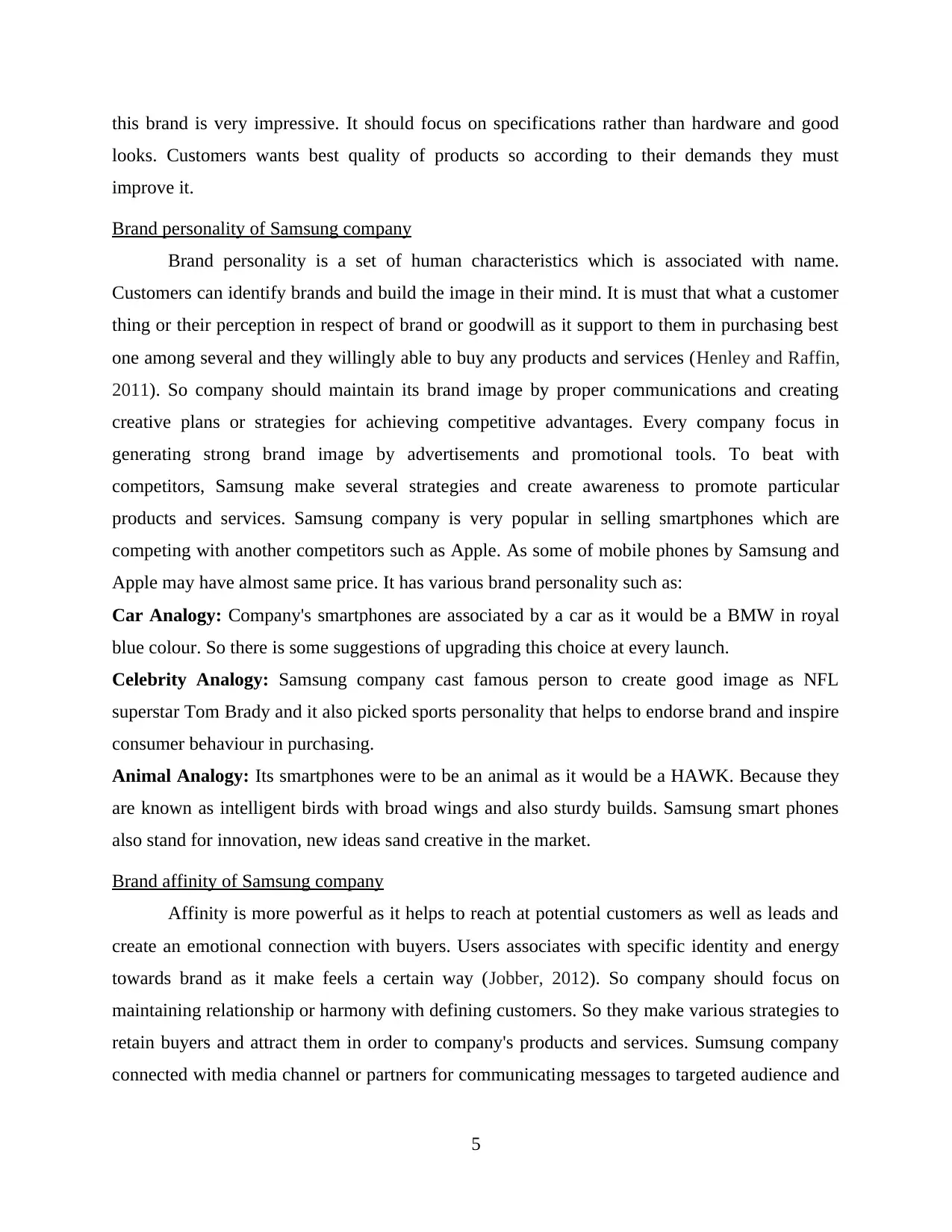
this brand is very impressive. It should focus on specifications rather than hardware and good
looks. Customers wants best quality of products so according to their demands they must
improve it.
Brand personality of Samsung company
Brand personality is a set of human characteristics which is associated with name.
Customers can identify brands and build the image in their mind. It is must that what a customer
thing or their perception in respect of brand or goodwill as it support to them in purchasing best
one among several and they willingly able to buy any products and services (Henley and Raffin,
2011). So company should maintain its brand image by proper communications and creating
creative plans or strategies for achieving competitive advantages. Every company focus in
generating strong brand image by advertisements and promotional tools. To beat with
competitors, Samsung make several strategies and create awareness to promote particular
products and services. Samsung company is very popular in selling smartphones which are
competing with another competitors such as Apple. As some of mobile phones by Samsung and
Apple may have almost same price. It has various brand personality such as:
Car Analogy: Company's smartphones are associated by a car as it would be a BMW in royal
blue colour. So there is some suggestions of upgrading this choice at every launch.
Celebrity Analogy: Samsung company cast famous person to create good image as NFL
superstar Tom Brady and it also picked sports personality that helps to endorse brand and inspire
consumer behaviour in purchasing.
Animal Analogy: Its smartphones were to be an animal as it would be a HAWK. Because they
are known as intelligent birds with broad wings and also sturdy builds. Samsung smart phones
also stand for innovation, new ideas sand creative in the market.
Brand affinity of Samsung company
Affinity is more powerful as it helps to reach at potential customers as well as leads and
create an emotional connection with buyers. Users associates with specific identity and energy
towards brand as it make feels a certain way (Jobber, 2012). So company should focus on
maintaining relationship or harmony with defining customers. So they make various strategies to
retain buyers and attract them in order to company's products and services. Sumsung company
connected with media channel or partners for communicating messages to targeted audience and
5
looks. Customers wants best quality of products so according to their demands they must
improve it.
Brand personality of Samsung company
Brand personality is a set of human characteristics which is associated with name.
Customers can identify brands and build the image in their mind. It is must that what a customer
thing or their perception in respect of brand or goodwill as it support to them in purchasing best
one among several and they willingly able to buy any products and services (Henley and Raffin,
2011). So company should maintain its brand image by proper communications and creating
creative plans or strategies for achieving competitive advantages. Every company focus in
generating strong brand image by advertisements and promotional tools. To beat with
competitors, Samsung make several strategies and create awareness to promote particular
products and services. Samsung company is very popular in selling smartphones which are
competing with another competitors such as Apple. As some of mobile phones by Samsung and
Apple may have almost same price. It has various brand personality such as:
Car Analogy: Company's smartphones are associated by a car as it would be a BMW in royal
blue colour. So there is some suggestions of upgrading this choice at every launch.
Celebrity Analogy: Samsung company cast famous person to create good image as NFL
superstar Tom Brady and it also picked sports personality that helps to endorse brand and inspire
consumer behaviour in purchasing.
Animal Analogy: Its smartphones were to be an animal as it would be a HAWK. Because they
are known as intelligent birds with broad wings and also sturdy builds. Samsung smart phones
also stand for innovation, new ideas sand creative in the market.
Brand affinity of Samsung company
Affinity is more powerful as it helps to reach at potential customers as well as leads and
create an emotional connection with buyers. Users associates with specific identity and energy
towards brand as it make feels a certain way (Jobber, 2012). So company should focus on
maintaining relationship or harmony with defining customers. So they make various strategies to
retain buyers and attract them in order to company's products and services. Sumsung company
connected with media channel or partners for communicating messages to targeted audience and
5
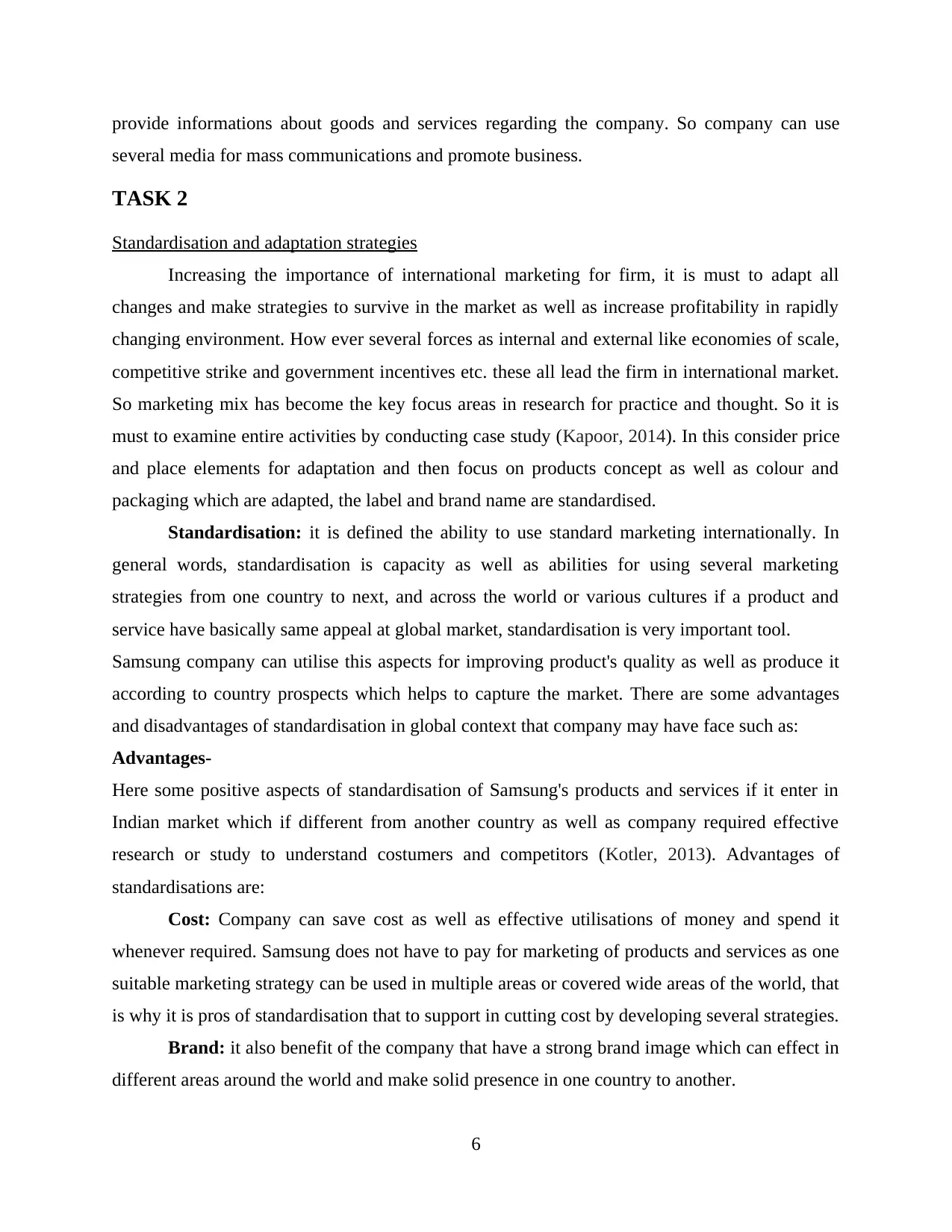
provide informations about goods and services regarding the company. So company can use
several media for mass communications and promote business.
TASK 2
Standardisation and adaptation strategies
Increasing the importance of international marketing for firm, it is must to adapt all
changes and make strategies to survive in the market as well as increase profitability in rapidly
changing environment. How ever several forces as internal and external like economies of scale,
competitive strike and government incentives etc. these all lead the firm in international market.
So marketing mix has become the key focus areas in research for practice and thought. So it is
must to examine entire activities by conducting case study (Kapoor, 2014). In this consider price
and place elements for adaptation and then focus on products concept as well as colour and
packaging which are adapted, the label and brand name are standardised.
Standardisation: it is defined the ability to use standard marketing internationally. In
general words, standardisation is capacity as well as abilities for using several marketing
strategies from one country to next, and across the world or various cultures if a product and
service have basically same appeal at global market, standardisation is very important tool.
Samsung company can utilise this aspects for improving product's quality as well as produce it
according to country prospects which helps to capture the market. There are some advantages
and disadvantages of standardisation in global context that company may have face such as:
Advantages-
Here some positive aspects of standardisation of Samsung's products and services if it enter in
Indian market which if different from another country as well as company required effective
research or study to understand costumers and competitors (Kotler, 2013). Advantages of
standardisations are:
Cost: Company can save cost as well as effective utilisations of money and spend it
whenever required. Samsung does not have to pay for marketing of products and services as one
suitable marketing strategy can be used in multiple areas or covered wide areas of the world, that
is why it is pros of standardisation that to support in cutting cost by developing several strategies.
Brand: it also benefit of the company that have a strong brand image which can effect in
different areas around the world and make solid presence in one country to another.
6
several media for mass communications and promote business.
TASK 2
Standardisation and adaptation strategies
Increasing the importance of international marketing for firm, it is must to adapt all
changes and make strategies to survive in the market as well as increase profitability in rapidly
changing environment. How ever several forces as internal and external like economies of scale,
competitive strike and government incentives etc. these all lead the firm in international market.
So marketing mix has become the key focus areas in research for practice and thought. So it is
must to examine entire activities by conducting case study (Kapoor, 2014). In this consider price
and place elements for adaptation and then focus on products concept as well as colour and
packaging which are adapted, the label and brand name are standardised.
Standardisation: it is defined the ability to use standard marketing internationally. In
general words, standardisation is capacity as well as abilities for using several marketing
strategies from one country to next, and across the world or various cultures if a product and
service have basically same appeal at global market, standardisation is very important tool.
Samsung company can utilise this aspects for improving product's quality as well as produce it
according to country prospects which helps to capture the market. There are some advantages
and disadvantages of standardisation in global context that company may have face such as:
Advantages-
Here some positive aspects of standardisation of Samsung's products and services if it enter in
Indian market which if different from another country as well as company required effective
research or study to understand costumers and competitors (Kotler, 2013). Advantages of
standardisations are:
Cost: Company can save cost as well as effective utilisations of money and spend it
whenever required. Samsung does not have to pay for marketing of products and services as one
suitable marketing strategy can be used in multiple areas or covered wide areas of the world, that
is why it is pros of standardisation that to support in cutting cost by developing several strategies.
Brand: it also benefit of the company that have a strong brand image which can effect in
different areas around the world and make solid presence in one country to another.
6
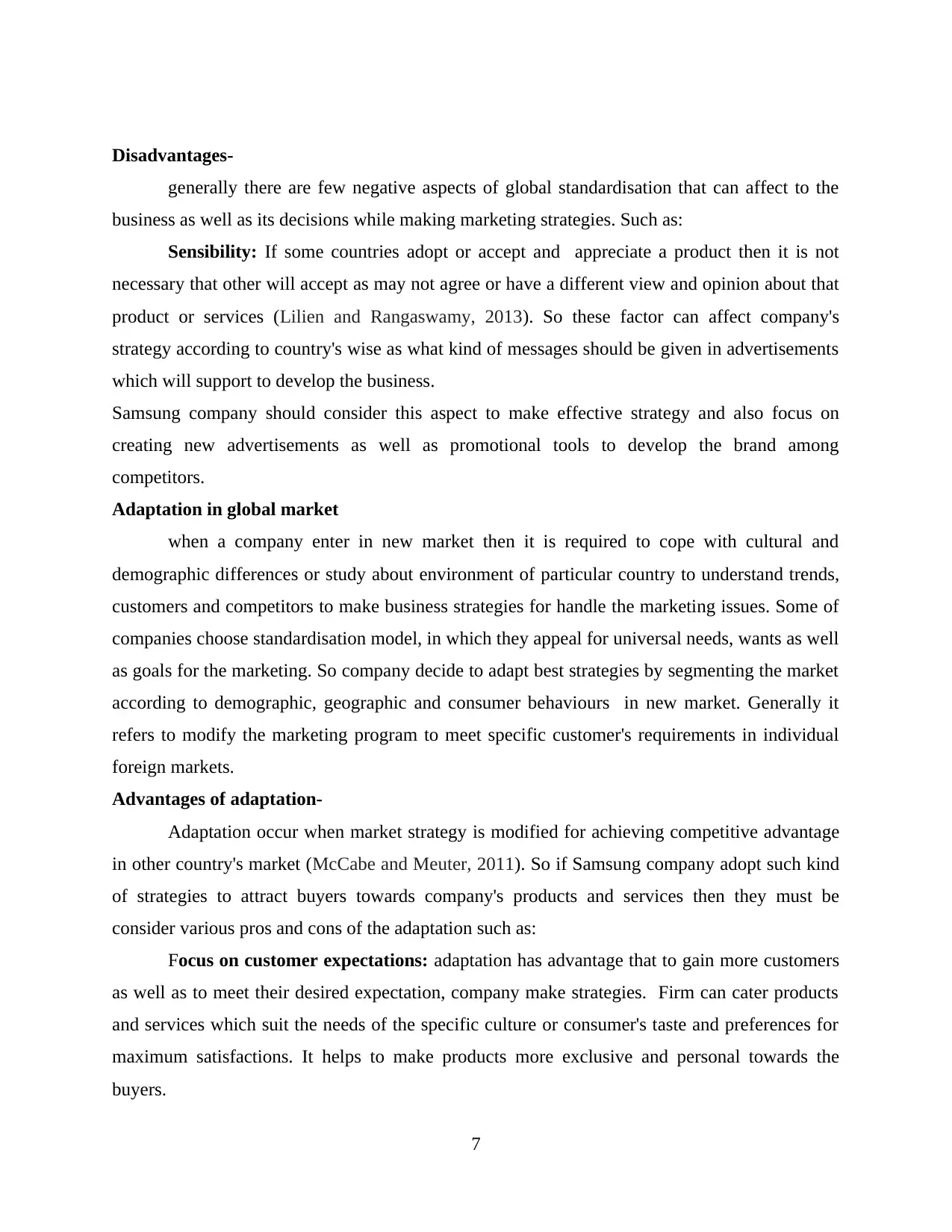
Disadvantages-
generally there are few negative aspects of global standardisation that can affect to the
business as well as its decisions while making marketing strategies. Such as:
Sensibility: If some countries adopt or accept and appreciate a product then it is not
necessary that other will accept as may not agree or have a different view and opinion about that
product or services (Lilien and Rangaswamy, 2013). So these factor can affect company's
strategy according to country's wise as what kind of messages should be given in advertisements
which will support to develop the business.
Samsung company should consider this aspect to make effective strategy and also focus on
creating new advertisements as well as promotional tools to develop the brand among
competitors.
Adaptation in global market
when a company enter in new market then it is required to cope with cultural and
demographic differences or study about environment of particular country to understand trends,
customers and competitors to make business strategies for handle the marketing issues. Some of
companies choose standardisation model, in which they appeal for universal needs, wants as well
as goals for the marketing. So company decide to adapt best strategies by segmenting the market
according to demographic, geographic and consumer behaviours in new market. Generally it
refers to modify the marketing program to meet specific customer's requirements in individual
foreign markets.
Advantages of adaptation-
Adaptation occur when market strategy is modified for achieving competitive advantage
in other country's market (McCabe and Meuter, 2011). So if Samsung company adopt such kind
of strategies to attract buyers towards company's products and services then they must be
consider various pros and cons of the adaptation such as:
Focus on customer expectations: adaptation has advantage that to gain more customers
as well as to meet their desired expectation, company make strategies. Firm can cater products
and services which suit the needs of the specific culture or consumer's taste and preferences for
maximum satisfactions. It helps to make products more exclusive and personal towards the
buyers.
7
generally there are few negative aspects of global standardisation that can affect to the
business as well as its decisions while making marketing strategies. Such as:
Sensibility: If some countries adopt or accept and appreciate a product then it is not
necessary that other will accept as may not agree or have a different view and opinion about that
product or services (Lilien and Rangaswamy, 2013). So these factor can affect company's
strategy according to country's wise as what kind of messages should be given in advertisements
which will support to develop the business.
Samsung company should consider this aspect to make effective strategy and also focus on
creating new advertisements as well as promotional tools to develop the brand among
competitors.
Adaptation in global market
when a company enter in new market then it is required to cope with cultural and
demographic differences or study about environment of particular country to understand trends,
customers and competitors to make business strategies for handle the marketing issues. Some of
companies choose standardisation model, in which they appeal for universal needs, wants as well
as goals for the marketing. So company decide to adapt best strategies by segmenting the market
according to demographic, geographic and consumer behaviours in new market. Generally it
refers to modify the marketing program to meet specific customer's requirements in individual
foreign markets.
Advantages of adaptation-
Adaptation occur when market strategy is modified for achieving competitive advantage
in other country's market (McCabe and Meuter, 2011). So if Samsung company adopt such kind
of strategies to attract buyers towards company's products and services then they must be
consider various pros and cons of the adaptation such as:
Focus on customer expectations: adaptation has advantage that to gain more customers
as well as to meet their desired expectation, company make strategies. Firm can cater products
and services which suit the needs of the specific culture or consumer's taste and preferences for
maximum satisfactions. It helps to make products more exclusive and personal towards the
buyers.
7
Secure Best Marks with AI Grader
Need help grading? Try our AI Grader for instant feedback on your assignments.
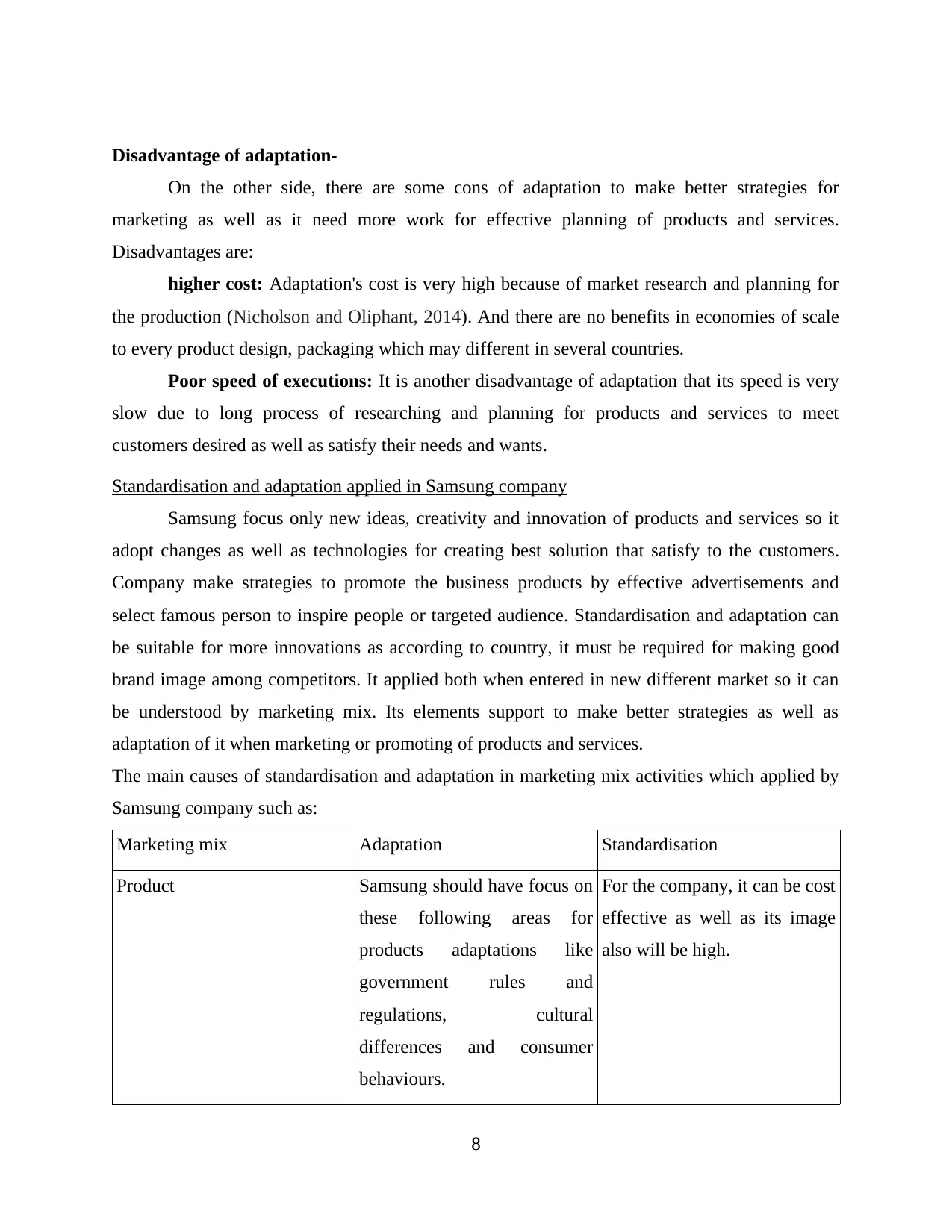
Disadvantage of adaptation-
On the other side, there are some cons of adaptation to make better strategies for
marketing as well as it need more work for effective planning of products and services.
Disadvantages are:
higher cost: Adaptation's cost is very high because of market research and planning for
the production (Nicholson and Oliphant, 2014). And there are no benefits in economies of scale
to every product design, packaging which may different in several countries.
Poor speed of executions: It is another disadvantage of adaptation that its speed is very
slow due to long process of researching and planning for products and services to meet
customers desired as well as satisfy their needs and wants.
Standardisation and adaptation applied in Samsung company
Samsung focus only new ideas, creativity and innovation of products and services so it
adopt changes as well as technologies for creating best solution that satisfy to the customers.
Company make strategies to promote the business products by effective advertisements and
select famous person to inspire people or targeted audience. Standardisation and adaptation can
be suitable for more innovations as according to country, it must be required for making good
brand image among competitors. It applied both when entered in new different market so it can
be understood by marketing mix. Its elements support to make better strategies as well as
adaptation of it when marketing or promoting of products and services.
The main causes of standardisation and adaptation in marketing mix activities which applied by
Samsung company such as:
Marketing mix Adaptation Standardisation
Product Samsung should have focus on
these following areas for
products adaptations like
government rules and
regulations, cultural
differences and consumer
behaviours.
For the company, it can be cost
effective as well as its image
also will be high.
8
On the other side, there are some cons of adaptation to make better strategies for
marketing as well as it need more work for effective planning of products and services.
Disadvantages are:
higher cost: Adaptation's cost is very high because of market research and planning for
the production (Nicholson and Oliphant, 2014). And there are no benefits in economies of scale
to every product design, packaging which may different in several countries.
Poor speed of executions: It is another disadvantage of adaptation that its speed is very
slow due to long process of researching and planning for products and services to meet
customers desired as well as satisfy their needs and wants.
Standardisation and adaptation applied in Samsung company
Samsung focus only new ideas, creativity and innovation of products and services so it
adopt changes as well as technologies for creating best solution that satisfy to the customers.
Company make strategies to promote the business products by effective advertisements and
select famous person to inspire people or targeted audience. Standardisation and adaptation can
be suitable for more innovations as according to country, it must be required for making good
brand image among competitors. It applied both when entered in new different market so it can
be understood by marketing mix. Its elements support to make better strategies as well as
adaptation of it when marketing or promoting of products and services.
The main causes of standardisation and adaptation in marketing mix activities which applied by
Samsung company such as:
Marketing mix Adaptation Standardisation
Product Samsung should have focus on
these following areas for
products adaptations like
government rules and
regulations, cultural
differences and consumer
behaviours.
For the company, it can be cost
effective as well as its image
also will be high.
8
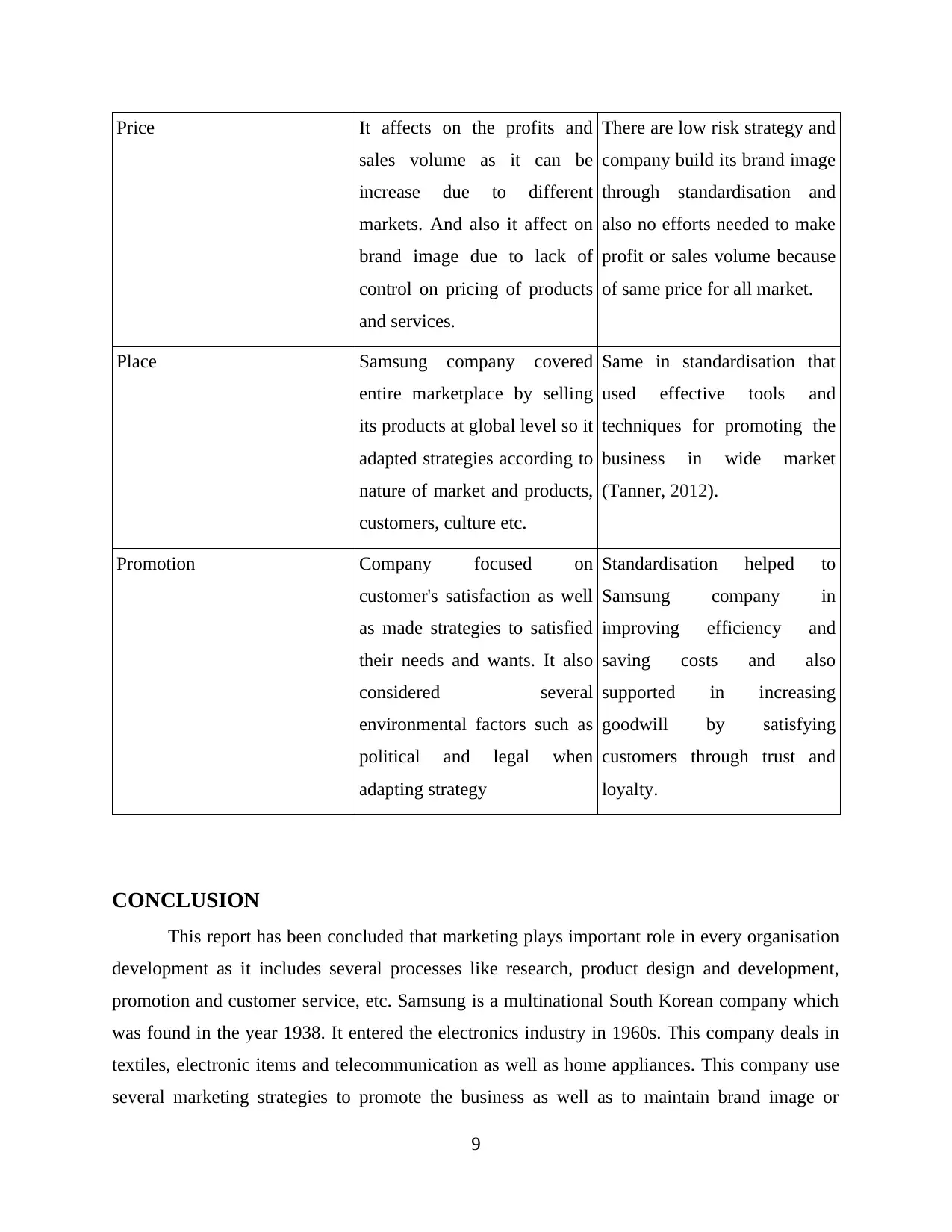
Price It affects on the profits and
sales volume as it can be
increase due to different
markets. And also it affect on
brand image due to lack of
control on pricing of products
and services.
There are low risk strategy and
company build its brand image
through standardisation and
also no efforts needed to make
profit or sales volume because
of same price for all market.
Place Samsung company covered
entire marketplace by selling
its products at global level so it
adapted strategies according to
nature of market and products,
customers, culture etc.
Same in standardisation that
used effective tools and
techniques for promoting the
business in wide market
(Tanner, 2012).
Promotion Company focused on
customer's satisfaction as well
as made strategies to satisfied
their needs and wants. It also
considered several
environmental factors such as
political and legal when
adapting strategy
Standardisation helped to
Samsung company in
improving efficiency and
saving costs and also
supported in increasing
goodwill by satisfying
customers through trust and
loyalty.
CONCLUSION
This report has been concluded that marketing plays important role in every organisation
development as it includes several processes like research, product design and development,
promotion and customer service, etc. Samsung is a multinational South Korean company which
was found in the year 1938. It entered the electronics industry in 1960s. This company deals in
textiles, electronic items and telecommunication as well as home appliances. This company use
several marketing strategies to promote the business as well as to maintain brand image or
9
sales volume as it can be
increase due to different
markets. And also it affect on
brand image due to lack of
control on pricing of products
and services.
There are low risk strategy and
company build its brand image
through standardisation and
also no efforts needed to make
profit or sales volume because
of same price for all market.
Place Samsung company covered
entire marketplace by selling
its products at global level so it
adapted strategies according to
nature of market and products,
customers, culture etc.
Same in standardisation that
used effective tools and
techniques for promoting the
business in wide market
(Tanner, 2012).
Promotion Company focused on
customer's satisfaction as well
as made strategies to satisfied
their needs and wants. It also
considered several
environmental factors such as
political and legal when
adapting strategy
Standardisation helped to
Samsung company in
improving efficiency and
saving costs and also
supported in increasing
goodwill by satisfying
customers through trust and
loyalty.
CONCLUSION
This report has been concluded that marketing plays important role in every organisation
development as it includes several processes like research, product design and development,
promotion and customer service, etc. Samsung is a multinational South Korean company which
was found in the year 1938. It entered the electronics industry in 1960s. This company deals in
textiles, electronic items and telecommunication as well as home appliances. This company use
several marketing strategies to promote the business as well as to maintain brand image or
9
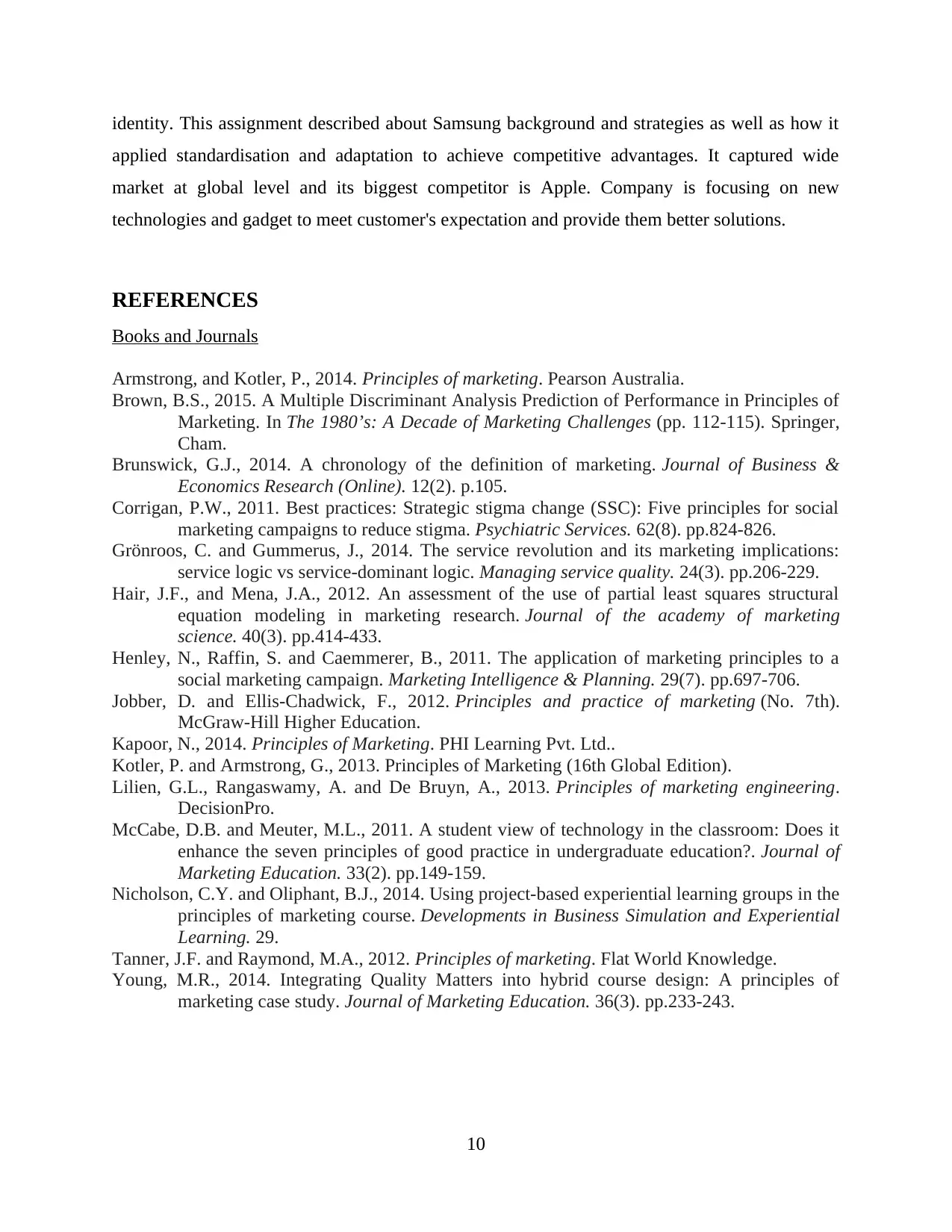
identity. This assignment described about Samsung background and strategies as well as how it
applied standardisation and adaptation to achieve competitive advantages. It captured wide
market at global level and its biggest competitor is Apple. Company is focusing on new
technologies and gadget to meet customer's expectation and provide them better solutions.
REFERENCES
Books and Journals
Armstrong, and Kotler, P., 2014. Principles of marketing. Pearson Australia.
Brown, B.S., 2015. A Multiple Discriminant Analysis Prediction of Performance in Principles of
Marketing. In The 1980’s: A Decade of Marketing Challenges (pp. 112-115). Springer,
Cham.
Brunswick, G.J., 2014. A chronology of the definition of marketing. Journal of Business &
Economics Research (Online). 12(2). p.105.
Corrigan, P.W., 2011. Best practices: Strategic stigma change (SSC): Five principles for social
marketing campaigns to reduce stigma. Psychiatric Services. 62(8). pp.824-826.
Grönroos, C. and Gummerus, J., 2014. The service revolution and its marketing implications:
service logic vs service-dominant logic. Managing service quality. 24(3). pp.206-229.
Hair, J.F., and Mena, J.A., 2012. An assessment of the use of partial least squares structural
equation modeling in marketing research. Journal of the academy of marketing
science. 40(3). pp.414-433.
Henley, N., Raffin, S. and Caemmerer, B., 2011. The application of marketing principles to a
social marketing campaign. Marketing Intelligence & Planning. 29(7). pp.697-706.
Jobber, D. and Ellis-Chadwick, F., 2012. Principles and practice of marketing (No. 7th).
McGraw-Hill Higher Education.
Kapoor, N., 2014. Principles of Marketing. PHI Learning Pvt. Ltd..
Kotler, P. and Armstrong, G., 2013. Principles of Marketing (16th Global Edition).
Lilien, G.L., Rangaswamy, A. and De Bruyn, A., 2013. Principles of marketing engineering.
DecisionPro.
McCabe, D.B. and Meuter, M.L., 2011. A student view of technology in the classroom: Does it
enhance the seven principles of good practice in undergraduate education?. Journal of
Marketing Education. 33(2). pp.149-159.
Nicholson, C.Y. and Oliphant, B.J., 2014. Using project-based experiential learning groups in the
principles of marketing course. Developments in Business Simulation and Experiential
Learning. 29.
Tanner, J.F. and Raymond, M.A., 2012. Principles of marketing. Flat World Knowledge.
Young, M.R., 2014. Integrating Quality Matters into hybrid course design: A principles of
marketing case study. Journal of Marketing Education. 36(3). pp.233-243.
10
applied standardisation and adaptation to achieve competitive advantages. It captured wide
market at global level and its biggest competitor is Apple. Company is focusing on new
technologies and gadget to meet customer's expectation and provide them better solutions.
REFERENCES
Books and Journals
Armstrong, and Kotler, P., 2014. Principles of marketing. Pearson Australia.
Brown, B.S., 2015. A Multiple Discriminant Analysis Prediction of Performance in Principles of
Marketing. In The 1980’s: A Decade of Marketing Challenges (pp. 112-115). Springer,
Cham.
Brunswick, G.J., 2014. A chronology of the definition of marketing. Journal of Business &
Economics Research (Online). 12(2). p.105.
Corrigan, P.W., 2011. Best practices: Strategic stigma change (SSC): Five principles for social
marketing campaigns to reduce stigma. Psychiatric Services. 62(8). pp.824-826.
Grönroos, C. and Gummerus, J., 2014. The service revolution and its marketing implications:
service logic vs service-dominant logic. Managing service quality. 24(3). pp.206-229.
Hair, J.F., and Mena, J.A., 2012. An assessment of the use of partial least squares structural
equation modeling in marketing research. Journal of the academy of marketing
science. 40(3). pp.414-433.
Henley, N., Raffin, S. and Caemmerer, B., 2011. The application of marketing principles to a
social marketing campaign. Marketing Intelligence & Planning. 29(7). pp.697-706.
Jobber, D. and Ellis-Chadwick, F., 2012. Principles and practice of marketing (No. 7th).
McGraw-Hill Higher Education.
Kapoor, N., 2014. Principles of Marketing. PHI Learning Pvt. Ltd..
Kotler, P. and Armstrong, G., 2013. Principles of Marketing (16th Global Edition).
Lilien, G.L., Rangaswamy, A. and De Bruyn, A., 2013. Principles of marketing engineering.
DecisionPro.
McCabe, D.B. and Meuter, M.L., 2011. A student view of technology in the classroom: Does it
enhance the seven principles of good practice in undergraduate education?. Journal of
Marketing Education. 33(2). pp.149-159.
Nicholson, C.Y. and Oliphant, B.J., 2014. Using project-based experiential learning groups in the
principles of marketing course. Developments in Business Simulation and Experiential
Learning. 29.
Tanner, J.F. and Raymond, M.A., 2012. Principles of marketing. Flat World Knowledge.
Young, M.R., 2014. Integrating Quality Matters into hybrid course design: A principles of
marketing case study. Journal of Marketing Education. 36(3). pp.233-243.
10
1 out of 13
Related Documents
Your All-in-One AI-Powered Toolkit for Academic Success.
+13062052269
info@desklib.com
Available 24*7 on WhatsApp / Email
![[object Object]](/_next/static/media/star-bottom.7253800d.svg)
Unlock your academic potential
© 2024 | Zucol Services PVT LTD | All rights reserved.




